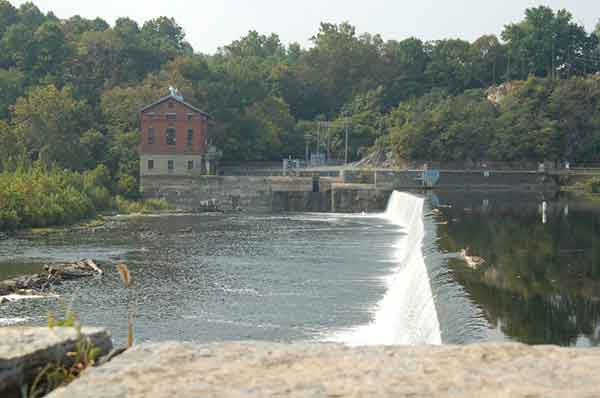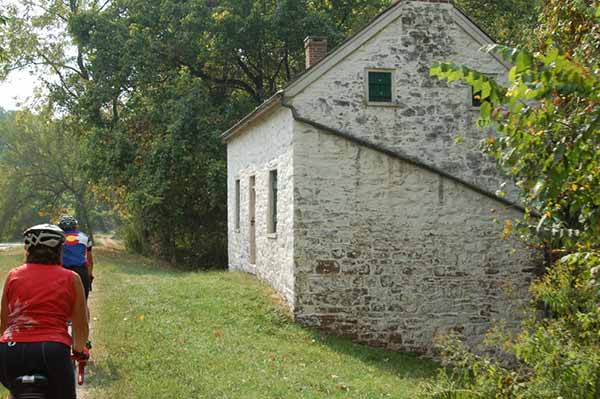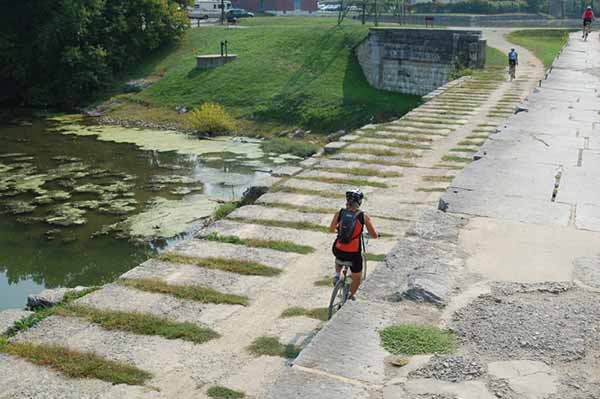C & O Canal, Dam 5 and Stonewall Jackson
This article appeared in the September, 2000 issue of “America’s Civil War.” It is reproduced here in its entirety with permission. For further reading visit: http://historynet.com or for anyone who wants to subscribe. (You will be leaving this site).
Stonewall Assaults Dam No. 5
Never one to rest on his laurels, Thomas ‘Stonewall’ Jackson planned a foray against an inviting target on the Potomac River—Dam No. 5. Any blow, he believed, was better than nothing.By Jason Barrett
In the early fall of 1861, the picturesque Shenandoah Valley in western Virginia was a land besieged. Half a year after the state had seceded, the valley was menaced by Union troops raiding from the mountains to the west and massing on the banks of the Potomac River to the north. Alexander Boteler, a Confederate congressman who hailed from the region, complained: “The condition of our border is becoming more alarming every day. No night passes without some infamous outrage upon our loyal citizens.”
Valley denizens clamored anxiously for relief from the Confederate government. One influential resident asked for “some competent regular or experienced officer of the army to take charge of and direct the whole military operations in this quarter.” In October 1861, this assignment went to Maj. Gen. Thomas J. “Stonewall” Jackson, who had won renown at the First Battle of Manassas that July. Jackson was a natural choice for the assignment, having lived and taught for 10 years in Lexington, in the southern portion of the valley.
The South needed to control the Shenandoah for several reasons. Most important, it was a populous agricultural region that supplied the Confederacy with both food and army recruits. It was also militarily important. A Union force moving eastward from the valley could fall on the flank of a Southern army defending Richmond. The topography of the Shenandoah Valley also benefited Confederate offensive strategy. Running in a southwest-northeast direction, it formed an ideal corridor for a potential invasion of the North. Finally, many Virginians revered the green, fertile land, and its loss would be a psychological blow to the South.
On November 5, Jackson arrived in Winchester, where he had been ordered to establish his head-quarters. Although not unduly large, Winchester was still the most prominent town in the northern end of the valley, and the network of roads passing through the community made it a valuable war prize to the contending armies. Winchester was about 25 miles southwest of Harpers Ferry, to which it was connected by an offshoot of the Baltimore & Ohio Railroad.
Despite the importance of Jackson’s assignment, however, General Joseph E. Johnston balked at orders from Richmond to transfer veteran troops from his army at Centreville to augment the small force of militia and cavalry in the valley. “[Jackson] will be opposed by raw troops. We [face] the enemy’s best,” Johnston wrote to Confederate Adjutant General Samuel Cooper. It took repeated requests to pry Jackson’s old volunteer brigade from Johnston and the intervention of President Jefferson Davis to quiet the commander’s complaints about the transfer.
The arrival of the Stonewall Brigade brought Jackson’s strength up to 4,000 effectives. The brigade had been recruited in the Shenandoah Valley and consisted of the 2nd, 4th, 5th and 27th Virginia regiments, along with the Rockbridge Artillery. The battery may have been the most religious in the Confederate service, boasting 25 theology students on its original muster roll and led by an Episcopal rector, Captain William Nelson Pendleton, who had christened the battery’s four guns Matthew, Mark, Luke and John.
There were more than 8,000 additional Confederate troops scattered throughout western Virginia, mostly under Brig. Gen. William W. Loring, at Huntersville, and Colonel Edward Johnson, guarding the Allegheny Mountain passes to the south-west. With Loring and Johnson available in a pinch, Jackson might have had enough manpower to keep the valley safe from Federal depredations during the winter. But North and South alike were soon to learn that Thomas Jackson, despite the nickname “Stonewall,” was incapable of remaining still for long. Indeed, he had been plotting to attack and push back the Northern soldiers from the moment he had received his new assignment.
Jackson’s first priority was recovering the town of Romney, 43 miles west of Winchester. The 5,000-man Union force occupying the town was a sword of Damocles suspended over Winchester and the northern valley. To add insult to injury, a Virginian from the Unionist far-western part of the state, Brig. Gen. Benjamin Kelley, commanded the troops garrisoning Romney. (Brig.-General Benjamin Franklin Kelley, pictured).
Kelley’s force had an unobstructed path to Winchester, and Jackson understood that the small Union army, continually being reinforced, would only become more potent if allowed to hibernate over the winter. “Let not the idea of Federal forces wintering in Romney be tolerated for one moment,” he warned Virginia Governor John Letcher.
In order to drive them out, however, Jackson would need more strength. He cast a covetous eye on Loring’s three brigades, which were preparing to go into winter quarters along the Staunton-Parkersburg Turnpike. In a November 20 letter to Secretary of War Judah Benjamin. Jackson proposed the capture of Romney and asked for Loring to be ordered to Winchester and added to his command. He admitted that a winter campaign would involve certain hardship, but he was optimistic of success “through the blessing of God.”
Impressed by the boldness of Jackson’s plan, the Confederate authorities endorsed it but nevertheless gave Loring the chance to veto the idea if he thought it unwise or too hazardous. A veteran officer who had lost an arm in the Mexican War, Loring agreed to participate in the campaign, but with little enthusiasm. Showing greater concern for the comfort of his soldiers than for the shrinking window of opportunity at Romney, he
sent his brigades to Jackson piecemeal and encumbered by heavy wagon trains. This meant a two- or three-week delay, during which time the Union force at Romney would grow before an attacking force could be fully assembled.
Annoyed and frustrated by the holdup, Jackson looked for an opportunity to strike some kind of blow at a target closer to Winchester. During the first week of December, he began to focus on Dam No. 5 on the Potomac River, seven miles up river from Williamsport, Md. Dam No. 5, as Jackson’s future adjutant general, Major Robert Dabney, later noted, was “built within a sharp curve of the river, concave toward the south, north of the town of Martinsburg [Virginia].” Constructed of a heavy wooden frame filled with quarried rock, it was the most pivotal of a progression of dams in the Potomac that forced water into the Chesapeake & Ohio Canal.
Since the Potomac was not navigable above Washington, the C&O Canal, running parallel to the river on the Maryland side, was one of the main avenues for traffic from the Ohio River to Washington and eastern Maryland. The canal had only been completed as far west as Cumberland, Md., but that was far enough to allow the North to make use- of the waterway as a supply route in conjunction with the Baltimore & Ohio Railroad. Although the Confederates had nullified the B&O east of Cumberland, the western track remained intact. So as long as the Federals could protect the western track of the B&O (which was Kelley’s main responsibility), goods could travel from the Ohio River Valley to Cumberland via rail and be transferred to canal boats to complete the journey to the capital area.
Destroying Dam No. 5 would effectively dry up the C&O Canal, cutting off the supply of Pennsylvania coal to factories and steamships in the Washington area. The canal was also used to transport Union troops and military supplies. If Jackson could successfully breach the dam, he could throw a wrench into the Northern military machine and cause an energy crisis in the enemy capital for at least the winter. “No force would be adequate,” Dabney believed, “to rebuild [the dam] amidst the ice and freezing floods of winter,” The time was ripe for the adventure, Jackson wrote Benjamin, because many empty cargo boats had been spotted traveling westward along the canal. Jackson proposed to strand these vessels and their valuable return cargoes of bituminous coal many miles from Washington.
On Saturday, December 7, Jackson dispatched a small strike force under Major Elisha Franklin Paxton of the 27th Virginia. Before the war, Paxton had been a lawyer and banker in Lexington, a friend of Jackson’s and an outspoken secessionist. (He had even quarreled with Jackson’s Unionist father-in-law on the subject.) As a result of their acquaintance, the general was familiar with Paxton’s talents and often assigned him to important detached duties.
Paxton arrived at the dam around sunset on the 7th and opened fire with artillery upon the small group of Federal pickets across the Potomac. The surprise shelling drove the Northerners from the riverbank and gave the Confederate dam-wreckers about five hours to slip into the water and hack away at the lumber frame undercover of darkness.
Correspondent Corporal Henry Bacon, 13th Mass., Co. D, sketched the first skirmish at Dam No. 5 for Frank Leslies Illustrated paper. (The caption gives him the incorrect rank of Captain). Bacon was wounded at 2nd Bull Run. He studied art in Paris and became a well-know artist after the war.
Around 11 p.m., Union reinforcements arrived in unexpected strength and forced the Confederates to the safety of the south bank, Colonel Samuel H. Leonard of the 13th Massachusetts, whose regiment was posted in the vicinity, led the Northern defense. Leonard reported to Maj. Gen. Nathaniel P Banks in Frederick, Md. Banks was a political appointee and military novice, and although his courage and patriotism were unimpeachable, he was fated to spend the first year of his army career as Stonewall Jackson’s hapless foil. Jackson once summed up Banks with the words, “He is generally willing to fight—and he generally gets whipped.”
But that sentiment would not hold true on December 8. Paxton later reported what happened next: “At daybreak Sunday morning our cannon opened fire upon them again, but they were so sheltered in the canal—from which in the meantime they had drawn off the water- -that it was found impossible to dislodge them. As my workmen could not be protected against the enemy s fire, I found it necessary to abandon the enterprise.” Paxton reluctantly led his men back to Confederate-held Martinsburg, 25 miles northeast of Winchester on the Valley Turnpike. There he dejectedly wrote his wife, “Entrusted with an important work, I have made a failure.” (Major Elisha Franklin Paxton, 27th Virginia, pictured).
Jackson admitted that “the injury done to Dam No. 5 is not sufficient to admit any passage of water on the Virginia side,” but he did not find fault with Paxton’s effort.
The pious Jackson was convinced that an engagement on the Sabbath had not received the Lord’s blessing and thus had been doomed to fail. In his official report, the miscarriage was attributed more securely to “the enemy’s resistance and want of adequate [Confederate means.” Now, with a better idea of what to expect, Jackson resolved to try again—and this time there would be no half-measures.
On December 10, Jackson temporarily transferred his headquarters to Martinsburg, less than a day’s march from Dam No. 5. He spent the next week planning his strategy and gathering men and materiel, even having some small boats built “for the purpose of crossing a party to the Maryland side [of the Potomac] if necessary.”
Jackson wrote optimistically to General Johnston, “If this plan succeeds—as through the blessing of Providence it will—Washington will hardly get any further supply of coal during the war from Cumberland.” Jackson was worried, however, about an advance by Kelley on Winchester, which he expected daily. That would force him to abandon his plans for the dam and prepare to defend the northern valley. But the potential rewards of the adventure—the shutting down of the C&O Canal—made it worth the Gamble.
Jackson himself would lead the second dam expedition, which consisted of the Stonewall Brigade, part or Brig. Gen. James H. Carson’s brigade of Virginia militia, and a cavalry detachment under the mercurial Lt. Col. Turner Ashby. At 6 a.m. on Monday, December 16, the troops moved out from camp near Winchester. They were reunited with Jackson near Martinsburg that night. After lightening their loads by leaving tents and knapsacks in town, they marched 14 more miles on the 17th and arrived, dog-tired, at the bluffs overlooking the Potomac around 9 p.m. characteristically wasting no time and taking full advantage of the darkness, Jackson set them to work that very night.
Contemporary View of Dam No. 5 and Lock Keeper’s House, February, 2005. © Brad Forbush, 2009.
Paxton’s previous foray had demonstrated that anyone attempting to wreck the dam was extremely vulnerable to fire from the Maryland shore. Jackson’s challenge was to reduce his soldiers’ danger as much as possible for as long as possible in order to give them a chance to do irreparable damage. Accordingly, he dispatched sentries along the Potomac near the dam to prevent any Union force from crossing in his rear and pinning his own men against the river. To further confuse Banks and Leonard and draw off some of their firepower Jackson sent Carson with some of his militia to make a demonstration at Falling Waters, near Williamsport.
Jackson concealed most of his remaining force behind a hill that afforded some protection from Federal cannons. Throughout the engagement, companies took turns on picket duty along the river. A cadre of Southern sharpshooters took over a nearby mill from which they could snipe at the Federals across the river. Captain Raleigh T. Colston of the 2nd Virginia was a native of the area and, in Jackson’s words, “well acquainted with the locality of the dam and its structure.” That first night Colston led a party of about 30 valley Irishmen equipped with crowbars, axes, picks and shovels down to the water.
Colston’s party crept halfway out along the dam and descended into the chilly waters on the Potomac. For a while they worked undetected in the darkness on the dam’s wooden supports. The Federals, however, soon detected their presence and drove the demolition crew back to the shore by midnight. Colonel Leonard had recognized Carson’s demonstration at Falling Waters as a diversion and had kept a sizable force on hand at the dam. Sporadic firing across the river went on throughout the night.
Leonard sent a dispatch to Banks early on the 18th, informing him of the situation. While Jackson was concerned about Kelley advancing from Romney, Banks, unsure of the Confederate strength, was worried about Jackson’s moving there to overwhelm Kelley—exactly what Jackson was looking forward to eventually doing. Banks was afraid that the operation at the dam might merely be a feint to throw Leonard off-balance and open the way for an assault on Romney. He warned his subordinate to keep this in mind, but his main concern, properly, was for the canal, though he was not sure whether Jackson’s real target was Dam No, 5 or Dam No. 4, a short distance downriver. (Col. S. H. Leonard, 13th Mass., pictured).
Banks ordered Colonel John R. Kenly of the 1st Maryland, then stationed in Frederick, to march “with all expedition to one or the other of these localities, as necessity may require or as movements of the enemy may dictate.” Kenly’s instructions were to cooperate with Leonard “to resist at all hazards the destruction of the dam or any efforts to cross the river.” Along with his own regiment, Kenly started forward with the 5th Connecticut, the 29th Pennsylvania, one detached company or artillery and two of cavalry. A nervous Banks urged both Kenly and Leonard to send frequent reports and anxiously offered reinforcements to both commands.
At daybreak on the 18th, while Carson was keeping the Federals busy at Falling Waters, Confederate artillery began thundering to cover another wrecking party. Jackson had posted two guns on top of the bluff commanding the river, one belonging to the Rockbridge Artillery and the other to the Ashby Horse Artillery, commanded by Captain R. Preston Chew, who just months earlier had been a cadet of Jackson’s at Virginia Military Institute. The artillerymen zeroed in on a brick house swarming with Union sharpshooters and had the satisfaction of watching them run”from the house like rats.”
Jackson’s workmen, meanwhile, helped their own cause by erecting a rough stone barrier across the top of the dam as partial protection against Federal musketry. Some also took to sheltering themselves in the cavities they were making in the dam. Leonard duly re-ported to Banks the commencement of hostilities in a 6:30 a.m. dispatch but said he was confident that he had the strength to hold off the attackers.
During the day, the tide turned against the Confederates. Leonard’s own artillery, a detachment of the 4th U.S., deployed in a grove of woods and commenced dueling with Jackson’s two guns. The Rebel gunners on the exposed bluffs were caught with no cover in a hurricane of projectiles. ”They had our range from the first and threw their shells right among us,” recalled Lieutenant William T. Poague of the Rockbridge Artillery.
As Poague scurried back to bring up the rest or his battery’s guns, his unfortunate comrades took what protection they could find among the few small saplings on the bluff. Artillery private George Neese recalled, “I laid so close to the ground that it seemed to me I flattened out a little, yearning for a leave of absence.” Guns and horses were left in the open, much to the chagrin of Jackson, who unsuccessfully exhorted his soldiers to abandon their cover. The Federal shelling finally ended just as Jackson’s additional guns finally came up, and the general decided to conserve his ammunition and cut short the artillery duel.
Jackson gloomily realized that he would get little accomplished during daylight. Not only was his artillery at a disadvantage, but laborers going to and from the crude fortifications in the middle of the dam were exposed to harrowing Federal gunfire, although, miraculously, none of his soldiers had been killed. Two infantry captains, Henry Robinson of the 27th Virginia and Frederick Holliday of the 33rd Virginia, volunteered to lead their companies into the water to resume the work after dark.
Jackson went down to the riverbank that night to hand out tools and encouragement to the volunteers. Again the intrepid Southerners crept out to the middle of the dam and slithered into the water. Dabney marveled at their fortitude: “The amount of fatigue which the men endured, laboring, as they constantly did, waist-deep in water, and in the intense cold of winter, can never be sufficiently appreciated.” The men lacked even the luxury of a campfire on the shore to warm themselves by, as no blazes were permitted so close to the enemy. The abstentious Jackson, however, was more generous than usual with the whiskey stores that night.
The Southerners soon learned that Leonard had his wits about him, as he demonstrated that smoking out sharpshooters was a game that two could play. Union artillery targeted the mill Jackson had taken over upon arriving and soon had it ablaze. This had the double benefit of uncovering Jackson’s nest of marksmen and giving Leonard’s own riflemen some light by which to fire upon Robinson’s and Holliday’s still toiling men. The Virginians did manage to inflict some damage to the structure, though the dam was still holding together.
In order to continue smashing away at the dam during the daylight hours, Jackson resorted to a ruse on the 19th. After daybreak, he began moving conspicuously down the Potomac with troops, wagons and pontoons, to give the impression that he was headed to try his luck at Dam No. 4, or possibly to cross the river. Leonard swallowed the deception long enough to dispatch his only battery and some infantry downriver, giving the Confederates in the river a few peaceful hours to batter at the dam’s supports. The Federals soon returned in force, however, and were joined later that day by Kenly’s regiments arriving from Frederick. The defenders once again cleared the river of Rebels. That evening, Banks reported: “Heavy firing most of the day…. Enemy driven from the dam.” (camp photo of members of the 13th Mass at Williamsport. Chandler Robbins standing left, unknown seated, Lt. Charles B. Fox seated far right. Barely visible inside the tent on the left, might be Lt. William Bacon).
Jackson spent part of the 20th’trying to finish the work on the dam. By 3 p.m., however, having only weakened the structure and caused some leakage, he decided to withdraw from the riverbank. Jackson no longer had any advantage of surprise, and the Federals had had four days in which to bring reinforcements to bear. Furthermore, Kelley’s troops were still in Romney, a fact that must have intruded often upon Stonewall’s thoughts during the campaign. Surely Loring would be at Winchester any day, if he was not already there, allowing Jackson to get on with the winter’s real work.
Spotting the Rebel withdrawal, Leonard quickly sent troops across the Potomac, which put an end to the project. At 6 a.m. on the 21st, Jackson’s force began the march back to Martinsburg, joined by Carson’s militia pulling back from FallingWaters. Two Confederate deserters, possibly bogus, materialized in the Union camp and reported Jackson’s host at a vastly inflated 15,000 men, discouraging any Federal pursuit.
Jackson proclaimed his expedition a success. His casualties had been remarkably light, one killed and four wounded. In a report to Johnston’s headquarters on December 24th, Jackson crowed he had ”reason to believe that the recent break in Dam No. 5 will destroy any vestiges of hope that might have been entertained of supplying Washington with Cumberland coal by the Chesapeake & Ohio Canal.” According to Dabney, writing several years later, “a great chasm was made, through which the whole current of the river flowed down toward its original level, leaving the canal far above it drained of its waters.” (Photo of canal boats lined up near Washington, D.C. C&O Canal NHP).
It turned out that these were substantial exaggerations, whether or not Jackson or Dabney realized it. In Dabney’s case, he was writing shortly after the war for an audience to whom Jackson, in death, had become a demigod, and some literary license was almost obligatory when describing his exploits. In Jackson’s case, he was appealing for reinforcements for his Romney campaign or, as he thought more likely, for defense against a thrust by Kelley toward Winchester. Although scrupulously honest, Jackson could play politics when necessary, and he may have been doing a bit of spin-doctoring to give extra urgency to his request for more troops. He followed the pronouncement of victory at Dam No. 5 with a pointed warning that the Federals would be able to resume the coal supply by repairing the B&O Railroad if he were not given adequate manpower to prevent them from doing so.
In fact, Washington’s coal supply had not been interrupted at all, for the Federals had already repaired the dam by the time Jackson wrote his report. As soon as Jackson left the riverbank on the 20th, the Federals could see that the structure was “but little injured,” and Banks sent a telegram to Leonard congratulating him on his defense of the dam. The following day, Leonard happily reported that canal boats were running without interference from Jackson’s Confederate soldiers. Photo of canal boats awaiting passage through the locks. (C&O Canal NHP).
William Poague of the Rockbridge Artillery admitted later that “the Yankees got the better of us.” After the war, the 5th Connecticut’s regimental historian, Edwin E. Marvin, also took issue with Dabney’s boastful account of the incident and cited a discussion with Captain Robinson of the 27th Virginia, who had been captured in March 1862. According to Marvin, Robinson “had freely admitted to the officers of our regiment, in frequent conversations, that the whole thing was a gigantic failure on their part.”
Although the Dam No. 5 expedition added little to the Stonewall Jackson mystique, some of the qualities that would make him a legend in his own time were already evident at this early stage of his career. His talent for audacious planning, his penchant for trickery, and his refusal to make allowances for human frailty all revealed themselves in the small operation. .Seemingly, only a lunatic would have sent men into an ice-cold river for hours at a time exposed to enemy fire, but when Jackson could envision grand results, he believed that with God’s favor he could always find a way to bring them about. Unlike many generals on both sides, Jackson believed in quick and decisive action, and the Confederacy would come to rely on his success in battle.
In early 1862—after Jackson had finally occupied Romney without a battle and been piqued by interfering orders from the Confederate War Department—he briefly tendered his resignation from the army. General Johnston’s rueful comment was, “I don’t know how the loss of this officer can be supplied.” After Jackson’s mortal wounding in May 1863 at the Battle of Chancellorsville, the answer would become plain: It could not.
Marlboro, Mass., author Jason Barrett wrote about General Albert Sidney Johnston’s journey to Texas in the September 1998 issue of America’s Civil War. For further reading, see: Stonewall Jackson, by James I. Robertson, Jr.; or Stonewall, by Byron Farwell.
Visit “Americas Civil War” for further reading or magazine subscriptions: http://historynet.com




